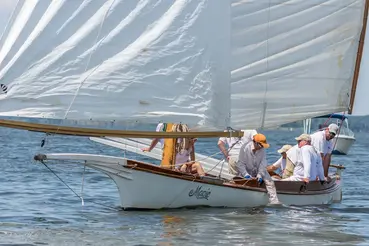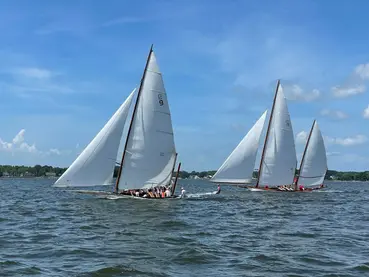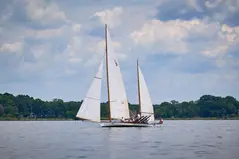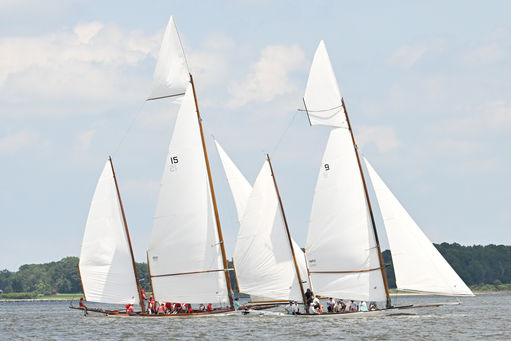THE HISTORY
Log canoe racing on the Chesapeake Bay has its roots in the hard work and quiet competition of 19th-century watermen. Originally, these boats were simple workboats, built from three or five logs skillfully joined to form the keel and sole. Skippers would race their heavily loaded canoes back to shore, eager to be first to the dock and earn the highest price for their oysters — sparking the tradition of making these boats ever faster, with larger sails and sleeker designs.
Over time, the workboat evolved into a vessel designed purely for speed and spectacle. Most of the log canoes racing today are between 75 and 100 years old, with fewer than two dozen remaining. They are instantly recognizable by their narrow beams, oversized schooner rigs, and their daring crews. The enormous sail area makes the boats highly unstable — prone to capsizing without the skillful teamwork of the sailors who act as human ballast. Perched on 15-foot springboards extending from the hull, these sailors shift from side to side with every tack, their movements a graceful, synchronized dance against wind and water. Watching them traverse the boards is a remarkable display of strength, balance, and timing.
As the old sailing adage goes: “If two boats are sailing the same course, there is a race going on whether the other captain knows it or not.” On the Chesapeake, this spirit of competition endures — a living tribute to the ingenuity and grit of the watermen who started it all.
THE LEGACY
A centuries-old Chesapeake tradition of craftsmanship, competition, and community — carried on by the few who dare to sail these living legends.
1600s–1700s: Origins
Native American dugout canoes inspire European settlers, who adapt the design by joining 3–5 logs for stability & capacity. The Chesapeake Bay log canoe is born.

Dugout Canoe (VMHC Rare Books F229 H27 1608L)

Watermen culling oysters, The Mariners’ Museum and Park
Early 1800s: Workhorses of the Bay
Log canoes dominate as the workboats of choice for oystermen & watermen, hauling catches and goods across the Bay.
Mid-1800s: The First Races
Rival watermen start racing each other back to shore to earn higher prices for their catch — sparking the competitive tradition.
1870s–1890s: Craftsmanship & Speed
Master builders like James Lowry create iconic boats such as Louise (later Mary Rider), Magic, and others — blending elegance & performance. Many surviving canoes date from this era.

"Mary Rider" Log Canoe - 1877
.webp)
"Magic" was built in 1894, by Charles Tarr in St. Michaels, Maryland
1920s–1930s: The Golden Age
Log canoe racing becomes formalized. Trophies like the Governor’s Cup, sponsored by Maryland’s Governor Ritchie, are introduced.
-
Mary Rider wins the Governor’s Cup 3 consecutive years (1928–30), crewed by Captain Bill Green & his daughters.
-
Magic, owned by Captain George “Bob” Wilson, becomes a fierce competitor.
1940s–1960s: Decline
With the rise of motorboats and modern workboats, log canoes fall out of use as working vessels. The number of canoes dwindles, and racing becomes rare.
1970s–Today: Revival & Preservation
Enthusiasts & preservationists restore the remaining fleet — fewer than 24 canoes remain, each lovingly maintained & still raced today. Notable survivors include:
-
Persistence, Island Bird, Magic, Mystery, and others.
-
Crews continue the thrilling tradition of “human ballast” on springboards, keeping this unique Chesapeake spectacle alive.



















